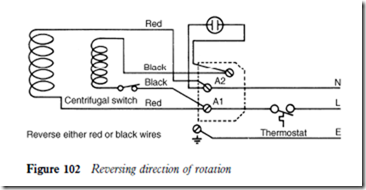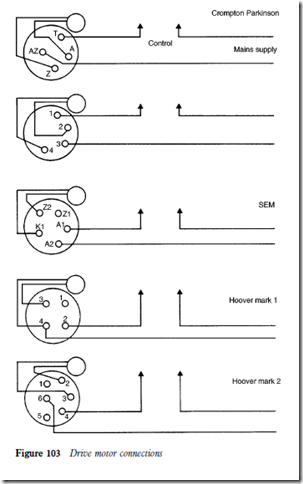Before installing or replacing a drive motor, it must be established that the voltage and frequency of the motor (as stated on the nameplate) agree with those of the supply.
A motor must not be connected to a supply outside the range stated on the nameplate. If connected to a low voltage supply it may not start. If it does start it may not run to its full speed; the windings will then overheat, and may burn out if continued starting attempts are made by the action of the overcurrent protector.
It is therefore important that the overload protector is of the correct rating if a replacement is made. Those fitted to open drive motors should be rated as near as possible to 125 per cent of the nameplate current.
Installation details
Earthing
The motor frame must always be connected to the local earth circuit. It is most important to ensure that the flexible earthing strip between the motor frame and the cradle is not broken and that the correct connection is made.
When water cooled systems are involved, under no circumstances must the water supply tubing be used for earthing.
Lubrication
Motor bearings should be lubricated at the time of installation or replacement. For sleeve bearings use high grade light mineral oil; for ball bearings use pure mineral grease.
Do not apply an excess of oil or grease, because excess lubricant can damage motor windings and switch mechanisms. Do not allow oil to contact the resilient rubber motor mounting pads. A small drop of oil should be applied to the swivel pivot.
Bearings
Worn bearings will probably be evident in the form of a hum or rattle from the motor.
The end play should not exceed 0.25 mm. If shims are used to correct the clearance or take up wear, they must not be fitted at one bearing only. This will result in the rotor being out of centre with the stator and will cause humming.
Thermal overloads
These are usually self-resetting after cooling. They are set to cut out when the temperature of the motor windings reaches approximately 90 °C (194 °F).
Nuisance tripping of a motor may be the result of poor ventilation of the motor or the load on the compressor. This should be checked before any replacement is made.
Direction of rotation
To reverse the rotation of a capacitor start motor, the direction of current flow in either the start or the run winding must be reversed (but not both windings). This entails reversing the internal connections of a winding, as shown in Figure 102. For three phase motors it is only necessary to reverse any two electrical leads to the motor terminals.
Suppliers of drive motors are numerous and the terminal identification is not standard. A variety of connections for motors in common use is provided in Figure 103.

